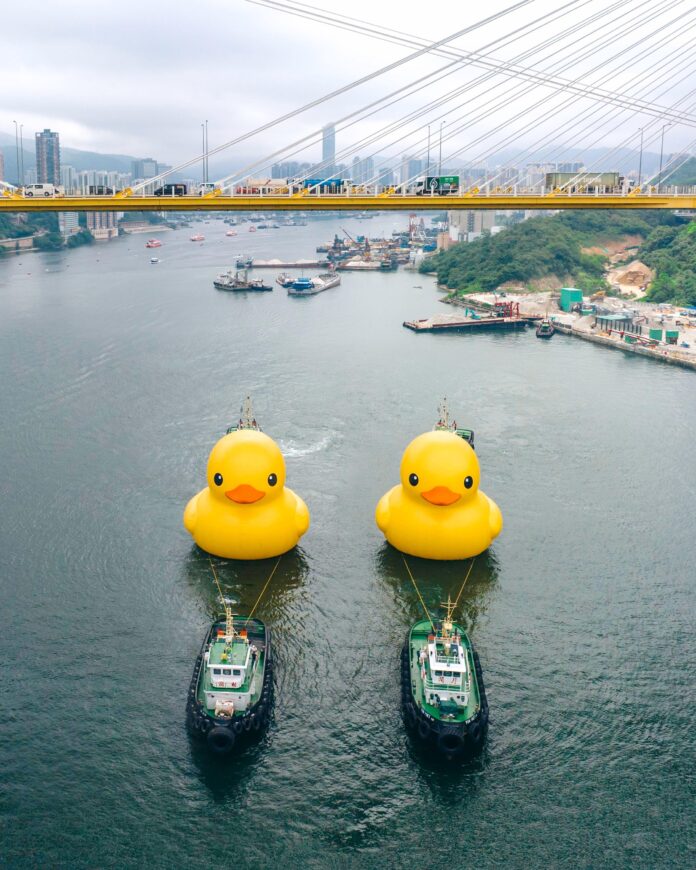The only thing Hongkongers go more quackers for than one giant inflated duck is two of them. This weekend Florentijn Hofman’s 18-metre-high bathtub fowl returned to the city a decade since its debut there, this time in duplicate.
Hofman’s Rubber Duck returns to a much-changed Hong Kong, one where lighthearted artotainment has become more common even as the mood is heavier following the 2019 protests and their suppression, three years of stringent zero Covid policies, and mass emigration out of the territory.
Even as expression has become increasingly clipped, so too has the appetite for art in public spaces as a last bastion of community spirit.
Hong Kong’s streets have been a site of cultural resistance since the 1950s when Tsang Tsou-choi, better known as the King of Kowloon, covered the city with his frantic anti-colonial calligraphy.
Now, accessible outdoor installations at local institutions provide rare pushback to Hong Kong’s sparse public areas, shrinking every year as the authorities curtail the lively weekend congregations of migrant workers from Southeast Asia. Curated museum projects join a range of artist pop-ups conceptual and performances as well as the crowd-pleasing cutesy murals and doubled-up duckies.
Hong Kong’s first March art week since the lifting of zero-Covid policies included an exuberance of public projects, as well as of public controversies; copies of Awol Erizku’s Gravity showed up for sale on web commerce site Taobao and Patrick Amadon’s No Rioters and Tyrrell Winston’s Double Technical were censored.
Amadon’s video, displayed on a screen outside Sogo Causeway Bay, was removed during fair week after the artist revealed it flashed references to jailed Hong Kong dissidents. Winston’s installation, a basketball court displaying the Winston tobacco trademark installed at Central’s Landmark mall, was covered up the following week due to civilian umbrage that it might promote smoking.
Beyond Hong Kong’s affluent collector base, the city’s educated middle class has evolved into an enthusiastic audience for art, as the 86,000 public visitors to this year’s Art Basel Hong Kong (23-25 March) attested.
The fair this year saw its Encounters, the curated section devoted to large-scale works, spill over into the public for the first time, with Erizku’s 10-metre-high inflatable King Tut placed in Central’s Pacific Place mall atrium. It was “simply due to practicality reasons” of size, says Amanda Hon, the managing director of Ben Brown Fine Arts in Hong Kong, which brought the work.
“The Hong Kong government doesn’t allow many areas for public displays of artworks, and if they do allow a space for a work, we have to go through mountains of paperwork and layers of bureaucracy for which we simply didn’t have sufficient time to sit and wait for approval. When government doesn’t step in to help the arts, the local Hong Kong community needs to do it ourselves,” Hon says. “We believed in showing art for the public and we made it happen. It’s what makes Hong Kong special, we are collaborative in making the entire ecosystem of art work here, despite the odds.”
Meant to premier at the Art Basel in Hong Kong edition that was cancelled in 2020, Gravity was secretly inflated last November, which hatched the idea of placing it somewhere more spacious and accessible, recounts Encounters curator Alexie Glass-Kantor. The Ethiopian-born, Los Angeles-based Erizku plans to “make a publication out of the work at Pacific Place; an artist book bringing together photos of people taking selfies,” compiling some of the “tens and thousands of people” who photographed the installation in the never-closed, metro-connected venue.
Glass-Kantor is unsure whether off-site Encounters will become a regular fixture, saying it depends on whether “there are works that feels appropriate for public space. As a curator, I’m not interested in just dropping things into public space for the sake of being in public.”
Pacific Place’s parent company, Swire Properties, has a long-running art space in the office building ArtisTree. This March, the property developer exhibited the scholar rocks of Hong Kong-based French artist Polo Bourieau. “What we tried to achieve in ArtisTree with Urban Rocks is to present and offer art in an alternative way,” away from the commercial. “Art is for the people! And my work simply tries to reconnect people with earth, meanings and… hopefully themselves,” Bourieau says. “Hong Kong is the most Chinese city and yet the most universal. The hope and quest for universality is probably what Hong Kong reflects the most in my work. Only when we acknowledge injuries and scars as historical tracks, can we design the maps of our desires.”

Polo Bourieau’s Urban Rocks were on show at ArtisTree Photo: © Pak Chung
Though the scars and protest art from 2019 have largely, if not entirely, been expunged from Hong Kong’s streets, a hunger for stifled civil discourse remains, even if redirected into safe, uncontroversial art. “It takes all types of art to engage the public,” Hon says. “Different works speak to different people and as they become more and more exposed, people’s tastes may change. As long as the works are making people think and delve deeper and learn more about art, I think it’s good.”

























